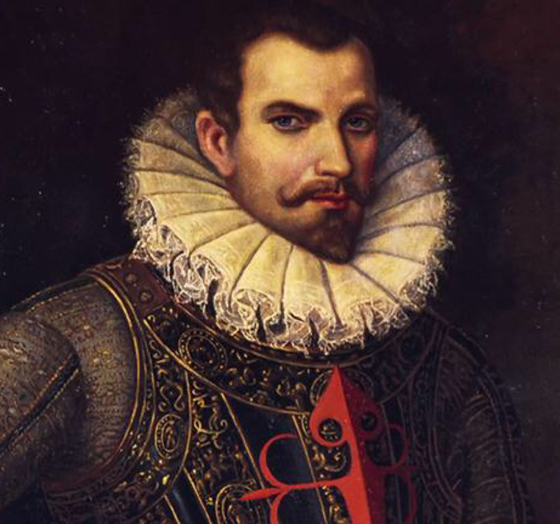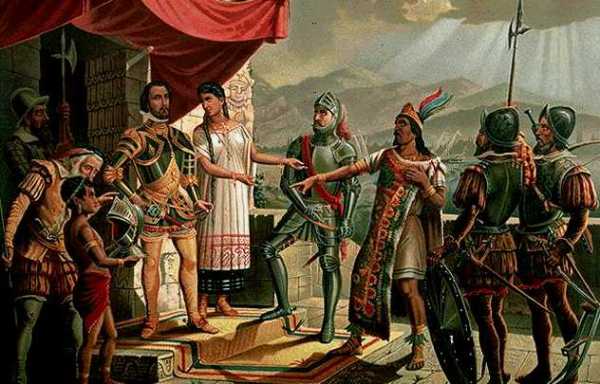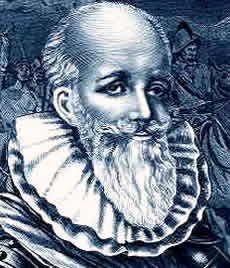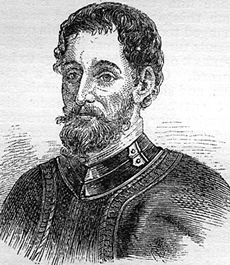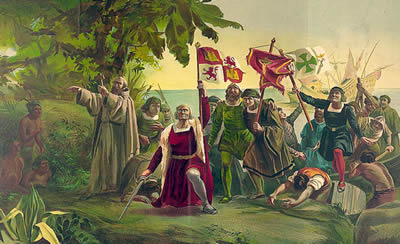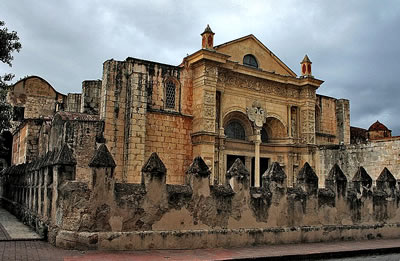 |
| Dominicans in the Americas |
When the first wave of
Spanish explorers and invaders came to the Americas, they were accompanied by a few clergy who served the sailors and military personnel as chaplains, but none of any note belonged to the Dominican order.
However it was a Dominican bishop, Diego de Deza, who first sponsored Christopher Columbus at the Spanish court and afterward took credit for Spain’s
opportunity to claim the West Indies. In 1508, the master of the Order of Preachers, Thomas de Vio (also known to history as Cajetan), called for 15 Dominican friars to be sent from the University of Salamanca in Spain to the island of Hispaniola (modern Haiti and Dominican Republic).
The first four friars arrived in 1510 at Santo Domingo and quickly made that stronghold their base of operations. They learned the indigenous language and proceeded to minister to both Spaniards and the local people. It did not take them long to become critical of the treatment of the natives by the Europeans.
These early friars refused the comfortable accommodations that were offered to them by the colonizers and instead moved into a simple hut where they began to share in communal life and common prayer and give support to each other’s ministry of preaching. Dominican criticism of the Spanish who were forcing natives to labor in mines and on estates is recalled in a number of early sermons aimed at colonists, soldiers, and representatives of the Crown.
In 1512, Dominicans traveled back to Spain and brought their criticisms of the Caribbean
encomendero system and its human rights violations directly to King Ferdinand V. Certain compromises with the Crown were put into effect in the form of modified laws that gave natives some protection, putting an end to child labor, as well as the exploitation of Native women.
The conversion to the Dominican order of a Spanish secular priest in the Caribbean, Bartolomé de Las Casas, proved to be instrumental in the struggles of the church against Native oppression. Bartolomé had come with the conquerors in 1502 and was given a huge portion of land to administrate, sharing in the fruits of Native exploitation and forced labor.
In 1524, he took on the Dominican habit and gave up his estates in Cuba. Through his writings (particularly Historia de las Indias) as well as his preaching and ministry, Bartolomé became an advocate for justice in the Spanish colonies.
Dominican professors of theology like Francisco de Vitoria (1485–1546) at Salamanca in Spain had argued against slavery using Thomistic principles to support the case for basic human dignity. Francisco was one of the first to condemn the
conquest of Peru by Francisco Pizarro, promoting instead a pastoral evangelization of the region.
Francisco de Vitoria is best known for his treatises Relecciones de Indias and De jure belli. Julián Garcés, the Dominican bishop of Tlaxcala in
New Spain, along with Las Casas and other friars sent petitions to Pope Paul III to become an advocate for the rights of natives in the Americas.
This resulted in the 1537 bull Sublimis Deus. In it Paul III wrote, “The Indians are truly men, and are not only capable of understanding the Catholic faith, but according to our
information they desire exceedingly to receive it....” This opened the door for continued missionary activity in Central and South America as well as the islands.
Antonio de Montesinos was among the first party of Dominicans to land in North America, near Georgetown, South Carolina, in 1526. They build a small church, San Miguel de Gualdape, and a temporary settlement where the expedition’s leader, Lucas Vásquez de Ayllón, was to die a few months later. He was buried there.
The following year de Montessinos abandoned the settlement and returned to the Caribbean where he was assigned by the Crown as protector to the natives of Venezuela. After some 15 years of service to the community in
Venezuela, Friar Antonio was murdered by a Spanish officer in 1540. The Maya and North America The Dominicans also sent missionaries to the Mayans. Luis Cancer, who served the community of Hispaniola as a young friar, was assigned in 1521 to the mission of San Juan in Puerto Rico. In 1542, he left San Juan to join Bartolomé de Las Casas among the
Maya in Guatemala.
The two friars learned the Mayan language and attempted to cooperate with the natives, delivering the message of the Gospel in the land the Spanish referred to as La Tierra de la Guerra (the land of war). Struggles between the Maya and Spanish had been ongoing in the region since the arrival of the invaders. Las Casas and Cancer even succeeded in translating Bible passages into Mayan song.
Friar Luis traveled unescorted into their lands and was said to have been welcomed by the Mayan people. Cancer next traveled to Florida in 1548 accompanied by a native woman and translator from the island of Hispaniola named Magdalena. She had been converted to Christianity by the Dominicans.
The party landed on the west coast of
Florida and Magdalena went ashore with Friar Diego de Tolosa and an oblate named Fuentes. Both of the Dominicans were killed and Magdalena was never found. The following year Luis Cancer was murdered near Tampa Bay during an effort by his landing party to make contact with the natives.
Earlier expeditions to North America by Hernando De Soto in 1539 had resulted in battles between natives and some 600 Spanish soldiers near Mobile. Three Dominican chaplains had accompanied the voyage that sailed out of Havana.
De Soto continued with his troops along the coast of Louisiana and ventured into parts of Mississippi, Arkansas, and Texas. The excursion ended in 1543 with Juan Gallegos being the only friar to survive. Subsequent Dominican missions to Florida were attempted in 1559 and in the early 1560s.
The first attempt by Tristán de Luna y Arellano and a talented Mexican preacher named Domingo de Salazar was abandoned for lack of food and terrible weather conditions. They were followed by Gregorio de Beteta, a former companion of the martyred Luis Cancer. The mission met with mixed
success.
Dominican foundations in Mexico had been highly successful as they were able to enlist both friars trained on the Continent as well as colonial Europeans born in the New World. They were reluctant however to accept Mesoamerican natives or even recruits of mixed blood. In 1526, they established a house in Mexico City.
By 1555, the province of St. James in Mexico counted some 210 friars residing in 40 houses. In the fall of 1528, Dominicans developing southern missions reached the town of Huaxyacac (modern Oaxaca). Among the friars making that journey were Father Gonzalo Lucero and Bernardino de Minaya.
A royal patent letter from Charles V bestowed upon Huaxyacac the rights of a city and it was given the name Antequera. They begin building the first Dominican priory there and dedicated it to St. Paul. By the 17th century, there were more than 70 priories functioning in the province of St. Hyppolitus in the Oaxaca area.
It took more than 50 years fully to complete construction of a magnificent new priory named after Santo Domingo. In 1623, Santo Domingo became a university offering degrees in theology and philosophy for both secular and religious clergy.
Peru Missionary work in Peru was initiated by the Dominicans when Vincent Valverde arrived in 1531. The Dominicans were successful in ministering to the Indians of Peru decades before Franciscan evangelizers. By 1544, the Dominican province in Peru had 55 members. Two of the most famous saints of Peru were Dominicans.
Saint Rose of Lima (1586–1617) was a Creole and member of the third (lay) Order of St. Dominic. Rose spent most of her life as a contemplative, living at her parents’ home, wearing a coarse habit and living the vow of perpetual virginity. Her life was devoted to prayer, penance, and fasting. It has been recorded that she slept on broken glass, potsherds, and thorns. She also constructed a crown of metal spikes and wore an iron chain about her waist.
Later in life, Rose retired to a small cell in the garden of her home where she spent her simpulan days in prayer and mortification. Visions, revelations, and divine voices were visited upon her. Rose’s death was reputedly followed by numerous miracles and in 1670 she was canonized by Pope Clement X.
Martín de Porres (1569–1639) was another famous Dominican saint of Peru. He was a mulatto from Lima, son of a free black woman and a white noble father. As a young man he received training as an apothecary (druggist), surgeon, barber, and physician. His skills were used to serve the poor.
He became a lay associate of the Dominican monastery of the Holy Rosary and later joined the community as a lay brother. He spent his life healing the sick, feeding the hungry, and attending to abandoned children. Martin was also reputed to have the gifts of visions, mystical experiences, miraculous healing, and even bilocation.
Interestingly, Saint Toribio, the arch-bishop of Lima, and St. John Massias (also a Dominican lay brother) were contemporaries of both Saint Rose and Saint Martín in Peru. The Dominicans maintained both urban and rural Peruvian missions, monasteries, and schools throughout the 16th, 17th, and 18th centuries.
The conquest of Colombia by Spain in 1536 and its eventual unification with Venezuela in 1549 produced the Audiencia of New Granada. This quickly became the domain of Dominican missionary activity. However unlike their efforts in Mexico and Peru, the Dominicans began to develop small missions and schools rather than monastaries.
By 1569, there were 40 small missions (or doctrinas); some 18 priories were also established. One of the leading Dominican figures in New Granada was Saint Louis Beltran (1526–81), who converted thousands of Natives to Christianity.
The running of schools and universities was among the special talents of the Dominicans. At Lima and in Mexico City universities were founded in the 16th century. In Guatemala the Real y Pontificia Universidad de San Carlos was recognized in 1676.
Universities were also founded in Bogotá (1627), Quito (1688), and Santiago, Chile (first as a college in 1619 and then as a university in 1684). Faculties included studies in logic, history, physics, philosophy, mathematics, theology, and canon law.
Early on, the Jesuits had begun to compete with the Dominicans in Latin America for students and had founded rival universities and colleges in Bogotá, Quito, Bolivia, and Santiago. During the 18th century, the Dominicans succeeded in establishing a university at Havana (1728), which was raised to the title of Royal and Pontifical University in 1734.
The end of the 17th century saw a rise in the number of Dominican foundations for women. There were 22 houses in Mexico City, 10 in Puebla, and a male monastery outside Oaxaca that was turned into a convent for Dominican nuns. The education of Spanish, Creole, and Indian women was undertaken in a number of these convents.
There were also separate convents for the education of the daughters of native chiefs (caciques). Indian women were rarely denied admittance to the Dominican order. The creation of female houses followed throughout the 18th century with convents established at Corpus Christi in Mexico (1724), Cosamalupan (1737), and Oaxaca (1782).


